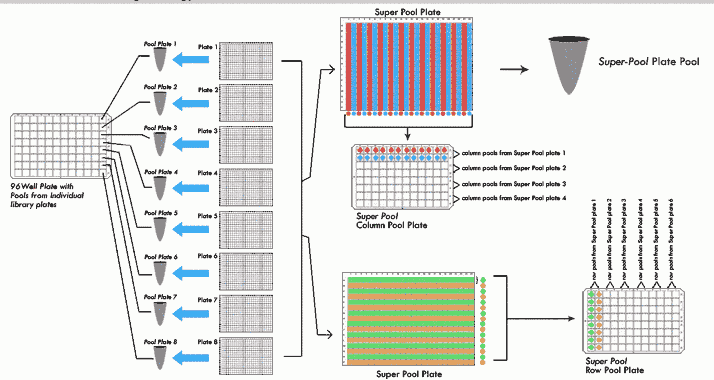Pools and Super Pools
Rx Biosciences performs the pooling of the library clones for screening by PCR. Pooling is performed after growing the individual clones separately to avoid the bias created due to different growth rates of the clones. Later, the clones are mixed together to form pools and super-pools. The DNA is isolated from the super-pools, plate-pools and row and column pools. The pooling strategy is provided below.
- Eight consecutive 384-wel plates, containing individually picked clones, are pooled together to form a Super-pool plate.
- For each super-pool plate, you will be provided with the corresponding plate pools (8), column pools (24) & row pools (16).
- Plate pool contains the DNA prepared from all the clones present in one of the eight 384-well plates (i.e. eight plate pool DNA for each super-pool)
- Column pool plate contains all BAC clone DNA from the same column of the eight 384-well plates (i.e. 24 column pools for each super-pool)
- Row pool plate contains BAC clone DNA from the same row of the eight 384-well plate (i.e. 16 row pools for each super-pool)
- Both, the glycerol stock and the DNA for the super-pools, plate pools and row &column pools are delivered.
Example: A library of 80 384-well plates will generate-
- 80 Plate pools [80 DNA preps]
- 10 Super-pool plate pools [10 DNA preps]
- 160 Row pools [160 DNA preps]
- 240 Column Pools [240 DNA preps]
The DNA and the glycerol stocks are supplied in 96-well plate(s) format for ease of setting PCR reactions for screening.
Screening Strategy:
- First PCR: Set up PCR using super-pool plate DNAs (e.g., 10 reactions to cover 80 plates)
- Second PCR: Once a super-pool is identified, set up PCR using the DNA from plate pools corresponding to the particular super-pool (8 reactions).
- Third set of PCR: Once a plate is identified, use DNA from row and column pools and locate the address of the clone. This will identify the position of the clone in the plate such as if row A and column 8 are positive, then the positive clone is A8.
Grow the positive clone, prepare DNA and confirm by additional methods such as Southern blots or PCR followed by sequencing of the PCR product.
A more simplified method of pooling (cost effective) can be found : Here

To receive a custom quote, please contact us. We look forward to hearing from you!
Receive a Quote




